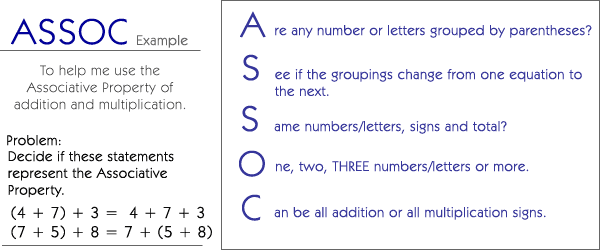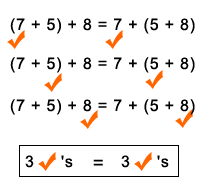 |
|
|||||
|
|
|
|
|
|
|
|
| |
|
|
||||

A re
any numbers or letters grouped by parentheses?
-
Highlight the parentheses in the equations. Make sure that for each set of equations, there is at least one that has numbers grouped by parentheses.
"I have highlighted the parentheses. In the first set of equations, numbers are grouped by parentheses in one of the equations. In the second set of equations, both equations have parentheses. Since I have numbers that are grouped by parentheses for at least one of the two equations, I can go on."
S ee if the groupings change from one equation to the next.
-
Underline each grouping to see if it changes.
" Now I need to look at the groupings of the numbers in each equation and see if they are different. In the first set equations, 4 + 7 are grouped together and there is no grouping in the second equation, so that is a change. In the second set of equations, 7 and 5 are grouped together in the first equation, but then the 5 and 8 are grouped in the second equation. So how numbers are grouped for each equation is different."
S ame numbers/letters, signs, and total?
-
Check and see if the:
-
Equations have the same numbers or letters.
-
Equations have the same operation signs.
-
Equations have the same total.
-
-
Look at the first number/letter in the first equation. Put a check under it. See if you can find that number/letter in the second equation. If you do, put a check under it. Do the same thing for each number and letter, the operation signs and the total.

"I have a 7 in the first equation, and here is one in the second equation, so I'll put a check underneath it. Now I'll look at the 5 and see if I can find it in the second equation, and then do the same thing with the 8. Now I'll look at the operation signs. I have addition signs on both sides. Finally, I need to check the totals. Both equations equal 20. I have the same numbers, the same operation signs and the same total for each equation."
O ne, two THREE
- Count the total number of checks you have made under the numbers for each equation. DON'T count the numbers in the total.
"I have 1,2,3 checks for the numbers in the first equation. And I have made 3 check marks under numbers in the second equation. So each equation has at least 3 numbers."
C an be all addition signs or all multiplication signs.
- Look at the equations. Highlight each sign in each equation to make sure that each one of them has only all addition or only all multiplication signs.
"I have all addition signs in these two equations. Each of the steps shows that these equations are examples of the associative property."
| |
|
|
|
|
|
|
|
| |
 |
||||||
|
|
|
||||||
| |
|
||||||
| |
|
|
|
|
|||
| |
|
|
|||||

